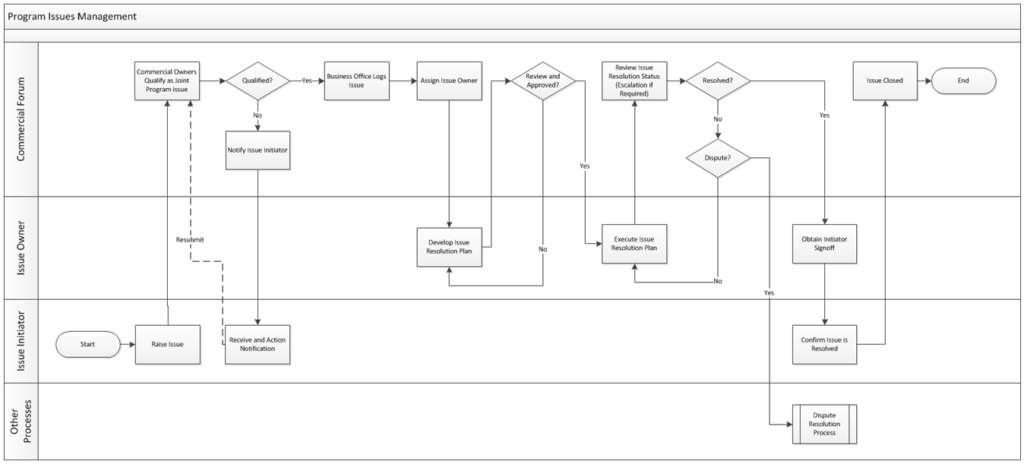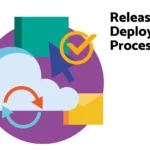
Program Issue Management Process Guide!
Issue Management Process
In this Issue management process blog, I have written it in a document style so that it can be copied and used directly into a document.
Program Issue Management Process
The Program Issues Management Process is the process used to receive, qualify and manage issues that require the intervention of <customer> or <your Organization> contract management team to facilitate resolution.
Objectives
The objectives of the Program Issues Management Process are to
- Ensure issues are captured and resolved within the shortest possible time-frame at the lowest operational level possible;
- Provide the escalation path, with criteria, from operational or project issue management to program issue management then ultimately to Dispute Resolution so that the resolution of the issue can be assigned to someone with appropriate authority;
- Track all open issues to closure; and,
- Protect the relationship between <customer> and <your organization)
This is done by the the following
- Establishment of a review meeting;
- Addition of issue monitoring to the agendas of contract meetings;
- Active tracking of issues; and,
- Logging issues and regularly updating and reporting status to the Commercial Review Meeting.
Scope
The Program Issues Management Process is used by <customer> and <your Organization> to manage and resolve all joint program issues, whether raised by <customer> or <your Organization>.
Operational or individual project-level issues, unless escalated to the central governance level, are excluded from this process and are managed within the delivery organizations. Similarly, day-to-day contractual issues may be managed directly by the Contract Managers.
Disputes are issues between <customer> and <your Organization> that cannot be resolved at the central governance level. These are managed by the Dispute Resolution Process as described in Dispute Resolution of the Infrastructure Transformation Services Agreement and are excluded from this process except for tracking and reporting their status.
Internal issues of either organization are outside the scope of this process.
The process begins when a joint program issue is raised and continues with ongoing tracking until the issue is resolved.
Policies
The following policies will apply to <customer> and <your Organization> in relation to this process:
- <customer> Technology Governance will be the focal point for issue status updates and reports within <customer>; and,
- The <your Organization>PMO will be the focal point for issue status updates and reports from <your Organization>.
Process Flow and Diagram
An issue is “a matter of concern” caused by some event which, if not resolved, will have an adverse impact on project or service commitments, client satisfaction or other program measurements.
A program issue is an issue that has been escalated to the point where resolution requires the involvement of either the <customer> Senior Management or the <your Organization> Senior Management or both. Due to their broad impact, some issues may inherently be program level and cannot be adequately addressed at a lower level.
The Program Issues Management Process has two phases
- Issue Initiation; and,
- Issue Management and Tracking.
It is expected that both <customer> and <your Organization> have an internal issues management process to handle its own internal issues. Joint issues, however, are shared between <customer> and <your Organization> necessitating an interface between the respective internal processes.
Policies
Other processes that may affect the Program Issues Management Process to be deployed include:
- Contract Change Management Process
- Formal Correspondence Process
- Contract Deliverables Process
Issue Management process flow

Process Steps
Program Issue Initiation
A program issue may be initiated when an initiator fills out a joint issue form (refer to Appendix A Forms (your task is to Create a form), in correspondence or by tabling and minuting the issue in the operational meeting.
The Commercial Review Forum provides the channel between <customer> and <your Organization> for all communications related to joint issues, including the ongoing communication of the status of open issues. The meeting is responsible for qualifying issues, approving resolution plans and ensuring status is tracked until the issue is resolved and closed or referred to the Dispute Resolution Process.
Raise Issue
The Issue Initiation phase shown in Figure 1 begins when a joint program issue is raised by either <customer> or <your Organization> and may arise, for example:
- If a delivery or project issue is unable to be resolved at the operational level;
- During the execution of other governance processes;
- As a result of a review or audit; and,
- As a result of an event that has a negative impact on contract commitments or client satisfaction.
Register Issue
A review is performed to verify that the issue qualifies as a joint program issue and that all information required for registering the issue has been provided. The issue is reviewed and noted by the <customer> and <your Organization> Governance Representative before the issue will be presented at the Commercial Review Forum and consequently the <your Organization>Performance Forum. The issue is registered by the <your Organization> PMO and a sequential number assigned to uniquely identify the issue. The issue form is then submitted to the next Commercial Review Forum for qualification.
Qualify Issue
The issue is qualified by the Commercial Review Forum. Agreed Resolution will normally be provided at Commercial and/or the HIS Performance Forum.
The Commercial Review Forum qualifies the issue and assigns a person with the appropriate skills and authority to resolve the issue as the Issue Owner. A target resolution date may be set at this time.
If an issue does not pass qualification the Issue Initiator is notified. The initiator may elect to modify the information previously provided and resubmit the issue, escalate the rejection, submit or return the issue to delivery or project processes for management.
The Issue Initiation phase ends when one of the following occurs:
- The issue fails qualification; and,
- The issue passes qualification and is passed to the Issue Management and Tracking phase.
Issue Management and Tracking
The Issue Management and Tracking phase begins after a registered issue passes qualification and needs to be tracked by the Commercial Review Forum.
Assign Issue Owner
When an issue passes qualification a person with the appropriate skills and authority to resolve the issue is assigned as Issue Owner. A target resolution date may be set at this time.
When an issue passes qualification, the issue moves into the Initiate Issues Management and Tracking phase and an Issue Owner then is responsible for resolving it.
Develop Issue Resolution Plan
The responsibility for resolving a joint program issue may rest with either <customer> or <your Organization>. In many cases the cooperation of resources from both organizations will be needed to produce a satisfactory resolution. If a target resolution date was set during the Initiate Issue phase, the Commercial Review Forum will track to the agreed date; alternatively, a mutually agreed date will be set during the meeting.
The Issue Owner develops an Issue Resolution Plan and is responsible for obtaining the agreement of stakeholders for the proposed resolution.
Issue Resolution Plan Reviewed
The plan is reviewed by the Commercial Review Forum
If the resolution plan is approved, the Issue Owner manages the implementation of the resolution.
If the resolution plan is not approved, it will be re-worked by the Issue Owner.
Execute Issue Resolution Plan
When the Issue Resolution Plan is approved, the Issue Owner manages the implementation of the resolution.
Review Issue Resolution Status
Issue resolution progress is monitored against the resolution plan. Any agreed adjustments to the issue owner/resolution plan will be made where necessary.
Issue Escalation
If all efforts have failed to resolve a joint program issue it may escalated to the contractually-defined Dispute Resolution Process.
Issue Complete
The Issue Owner is responsible for obtaining the agreement of the Issue Initiator that the issue is resolved.
When complete, the Commercial Review Forum endorses the closure of the issue.
The Issue Management and Tracking phase ends when the issue is resolved.
If the issue results in a Contract Change, please refer to the Contract Change Management Process
Issue Formal Closure
The Commercial Review Forum endorses the issue for formal closure; The <your Organization> PMO will update the issue form with agreed resolution and approval. The updated Program Issue form is then submitted to <customer> Technology Governance for audit records.
Roles and Responsibilities
<customer>
<customer> representatives are responsible for:
- Performing the roles defined by the meeting charter for the Commercial Review Forum in the Governance Plan as appropriate;
- Participating in the review of the status of all open Program Issues in accordance with the schedule and agenda for the Commercial Review Forum; and
- Working with <your Organization> to resolve all Program Issues in a timely manner.
<your Organization>
<your Organization> representatives are responsible for:
- Performing the roles defined by the meeting charter for the Commercial Review Forum in the Governance Plan as appropriate; and,
- Participating in the review of the status of all open Program Issues in accordance with the schedule and agenda for the Commercial Review Forum; and
- Working with <your Organization> to resolve all Program Issues in a timely manner.
Commercial Review Meeting
The members of the Commercial Review M Forum meeting are specified in the Governance Plan and maintained by the Business Office. It is responsible for:
- Ensuring a joint program issue is registered;
- Convening, in accordance with the meeting schedule and agenda detailed in the Governance Plan;
- Qualifying new joint issues;
- Assigning issue owners;
- Assigning issue priority as required;
- Agreeing the planned resolution date;
- Reviewing the status of joint issues;
- Approving resolution plans;
- Reviews resolution progress against the plan and may change the priority of the issue;
- Approve additional resources, assign a new owner or request changes to the resolution plan as required to accomplish effective and timely resolution of the issue;
- Communicating to initiator, <customer> Technology Governance and <your Organization> PMO if a Program Issue results in a Contract Change;
- Escalating joint issues that cannot be resolved at the program level to the contractually‑defined Dispute Resolution Process; and,
- Approving the closure of joint issues.
Issue Initiator
The Issue Initiator is responsible for:
- Ensuring that all operational avenues for resolving the issue have been exhausted prior to submitting a program issue;
- Completing and submitting the Issue Form when used;
- Reviewing and agreeing to the resolution proposed by the Issue Owner; and,
- Agreeing to the closure of the issue.
Issue Owner
The Issue Owner is assigned by the Commercial Review Forum and is responsible for:
- Managing assigned issues to resolution;
- Developing the resolution plan and gaining the agreement of stakeholders, including the Issue Initiator;
- Managing the implementation of the resolution plan;
- Obtaining the sign-off of the Issue Initiator that the issue has been resolved; and,
- Providing updated Issue Forms, if used, and status updates at the required frequency.
Authored by Vijay Chander – All rights reserved – 2023

